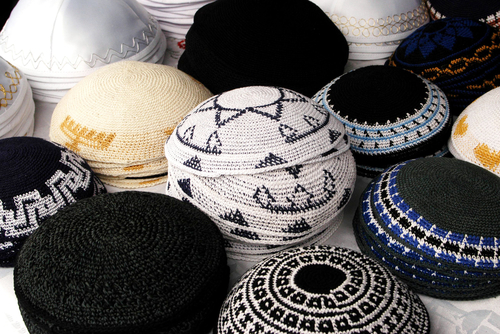
I have been considering a major Jewish life style change.
I have been considering wearing a kippah full time.
That was not part of my Jewish childhood. Quite the contrary.
I have no memory of ever wearing a head covering at any family Shabbat dinner or Passover seder. At the synagogue where I grew up on Long Island, it was actually against the rules to wear a kippah on the bima at that synagogue, and the rabbi and synagogue leaders even looked askance at those who chose to wear one in the pews.
This was a product of classical Reform Judaism – an American Judaism that proudly proclaimed, in the so-called Pittsburgh Platform of 1885:
We hold that all such Mosaic and rabbinical laws as regulate diet, priestly purity, and dress originated in ages and under the influence of ideas entirely foreign to our present mental and spiritual state. They fail to impress the modern Jew with a spirit of priestly holiness; their observance in our days is apt rather to obstruct than to further modern spiritual elevation.
You can read the history of Jewish head coverings here. The head covering became symbolic of what it meant to be a pious Jewish man.
Let us now move to America. For a Jew to go bareheaded symbolized something very simple: that Jew wanted to become part of American culture.
Consider the words of the late Herman Wouk, who recently died at the age of 103.
In his autobiographical novel, Inside Outside, he creates his alter ego, I. David Goodkind – raised in an Orthodox family, attends Talmudical Academy – and who desperately wants to go on to Columbia University. He writes about going to his interview on campus:
The students strolling the brick walls looked to me like extras in a college movie: the boys all spiffy and gentile, the girls all elegant and gentile, their clothes all collegiate and gentile. Not a yarmulke in sight!
To go bareheaded in public – that was the new American Jewish ideal.
What about the Orthodox?
Consider the most prominent Orthodox Jew in America: Jared Kushner. You might have noticed that Jared Kushner does not wear a kippah. Neither does former Senator and vice presidential candidate, Joseph P. Lieberman, who is an observant Jew.
The truth is: It was not until relatively recently that Orthodox men wore kippot outside the home.
The late Rabbi Joseph Lookstein, one of this country’s most prominent Orthodox rabbis, had always taught that the kippah was an “indoor garment.” You wore it at home. Not on the street. To paraphrase Herman Wouk: The kippah was for inside; the bare head was for outside. Inside the home, you were a pioius Jew; outside the home, you would be an undifferentiated American.
So, when did Jewish men – and then, Jewish women – start wearing kippot in public? It was during the Soviet Jewry movement – when we donned the kippah or yarmulke as a symbol of Jewish ethnic pride and solidarity.
My own personal practice? I wear a kippah when I pray; when I study; when I teach; when I eat in a kosher restaurant.
So, why, then, would I consider wearing a kippah in public?
It is about what is happening in Germany today. There has been a dramatic rise in violent antisemitism – both physically and verbally. Recent government statistics show a 20 percent rise in the number of antisemitic crimes reported in the past year, with a total of about 1,800 in 2018. The vast majority of crimes for which a perpetrator or motive is known were attributed to the far-right wing. Read last week’s story in the New York Times magazine. It is startling.
As a result, Germany’s commissioner on antisemitism, Felix Klein has said: It is dangerous to identify publicly as Jewish in Germany. In an interview with the Berliner Morgenpost on May 24, Felix Klein said: “I can’t recommend that Jews can wear a kippah everywhere and any time. Sad to say.”
And yet, others have called on German Jews and non-Jews to wear the kippah – as a sign of pride, as a sign of defiance, and as a sign of solidarity.
Why, then, do I hesitate to put on a kippah in public?
I have discerned that the settings in which I wear a kippah – prayer, study, and eating at kosher establishments – all have one thing in common.
These are places where I demonstrate – to myself, to God, and to others – a certain level of piety, and a certain level of havdalah – of distinctive behaviors, and of kedusha, of holiness.
- To pray is to speak. But it is a different kind of speech. When I speak to others, I am bareheaded. When I expect to speak to God, I cover my head. It reminds me of what is above me.
- To study Torah is to learn. But, it is a different kind of learning. When I read a biography of Abraham Lincoln, I am bareheaded. When I read the words of the biblical Abraham, in the original, I cover my head. It reminds me of what is beyond me.
- To eat in a kosher restaurant is to eat. But, it is a different kind of eating. When I go into an Italian restaurant, I eat bareheaded. When I eat in a Jewish manner, with other Jews, in a Jewish restaurant, I cover my head. It reminds me of what is within me.
Were I to start wearing a kippah in public, it would be for one reason, and for one reason only: to be defiant. That is not the reason for the kippah.
It is not to identify the haters.
It is to identify with God.
I do not wear a kippah because they hate me.
I wear a kippah because God loves me.
